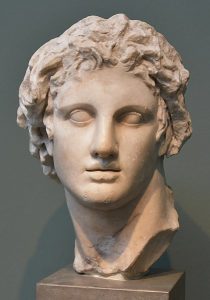Hellenism as a Cultural Phenomenon, Lawrence H. Schiffman, Reclaiming the Dead Sea Scrolls, Jewish Publication Society, Philadelphia, 1994.

Bust of Alexander the Great. By Richard Mortel from Riyadh, Saudi Arabia – Alexander the Great, from Alexandria, Egypt, 3rd cent. BC, Ny Carlsberg Glyptotek, Copenhagen (5), CC BY 2.0, https://commons.wikimedia.org/w/index.php?curid=69756683
The Greek city-state, known as the polis, was the vehicle for the assimilation and Hellenization of the natives. Such city-states, populated mostly by native Near Easterners, were the cultural melting pots of the East, the home of institutions that promoted the Greek way of life- schools, theaters, and gymnasia. They also expressed Greek culture through athletic contests, Greek language and literature, architecture, and philosophy. Native Near Easterners gravitated to the arts and sciences of the Hellenic world, soon taking the lead in such disciplines as literature and philosophy. The Greek emphasis on physical culture and beauty also spread throughout the Near East. The religion of the Greeks gradually fused with native religions in the form of many different local cults. The official cult of the polis encouraged the constant symbiosis of Greek and Near Eastern elements.
Reacting to this overwhelming influence, natives often redefined and reinterpreted their own traditional cultures in light of what they considered their modern civilization. This process of reinterpretation gave rise to several varieties of Hellenistic Judaism—and to a bitter struggle over how much accommodation to Hellenism each group would tolerate.
Pages 67-68
What do you want to know?
Ask our AI widget and get answers from this website